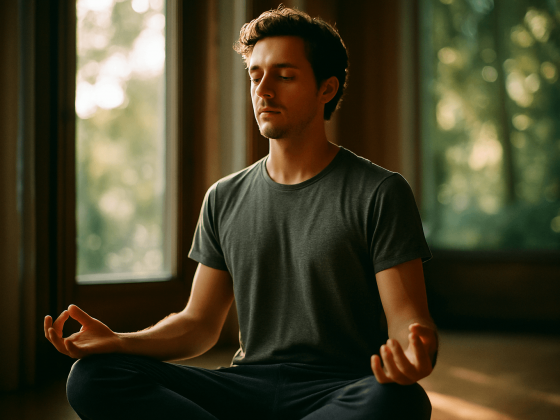Introduction to Mindfulness
Mindfulness meditation is a powerful practice that involves paying attention to the present moment with intention and awareness.
Practicing mindfulness helps reduce stress and anxiety by calming the body and mind.
Mindfulness based stress reduction (MBSR) is a program that combines meditation, yoga, and mindfulness practices, with a strong emphasis on focusing on the breath or bodily sensations as a core component of mindfulness meditation.
Regular practice of mindfulness meditation retrains the mind to settle, fostering true presence without intellectual overlay.
Mindfulness exercises may offer various mental and emotional benefits, including reduced symptoms of anxiety and depression. A recent meta-analysis supports the effectiveness of mindfulness practices in reducing anxiety and depression, highlighting the strength of the evidence base.
Benefits of Mindfulness Meditation
Mindfulness meditation supports mental health and helps manage various conditions, including anxiety and depression. It also strengthens the mind-body connection by linking mental and physical health, showing how practices like mindfulness can help address both emotional and physical symptoms.
Preliminary studies show meditation benefits people with asthma and fibromyalgia, reducing physical pain and improving overall well-being.
Meditation promotes balanced and accepting experiences of thoughts and emotions, leading to deep healing and self-awareness.
Clinical trials confirm meditation’s effectiveness for emotional well-being, reducing stress and anxiety symptoms.
Mindfulness practice can also improve focus, concentration, and problem-solving skills, leading to greater overall well-being. Additionally, mindfulness boosts creativity, allowing individuals to approach challenges with fresh perspectives and innovative solutions.
Getting Started with Mindfulness
To start practicing mindfulness, find a quiet space where you can sit comfortably and focus on your breath. The easiest way to practice mindfulness is to focus on the breath, resting your attention on the inhalation and exhalation repeatedly.
Begin with short periods of meditation, such as 5-10 minutes, and gradually increase as you become more comfortable with the practice.
Mindfulness exercises can be practiced anytime and anywhere, making it easy to integrate mindfulness into your daily routine. Simple mindfulness exercises can be practiced in various settings, whether at home, work, or during a commute.
Start with simple mindfulness exercises, such as focused breathing and sensory awareness, to bring awareness to the present moment.
You can also use guided meditation recordings to help you get started with your mindfulness practice.
How to Practice Mindfulness
- To practice mindfulness, pay attention to your thoughts, emotions, and bodily sensations without judgment or attachment –
- Focus on the present moment, letting go of worries about the past or future –
- Use your breath as an anchor to the present moment, bringing your attention back to it when your mind wanders –
- Practice mindfulness in daily activities, such as eating or walking, to cultivate greater awareness and appreciation –
- Remember that mindfulness is a practice, and it’s okay if your mind wanders – simply acknowledge the thought and return to the present moment –
Mindfulness Exercises
- Simple mindfulness exercises include body scan meditation, sitting meditation, and walking meditation –
- You can also practice mindfulness through yoga, tai chi, or other mind-body exercises –
- Mindfulness exercises can be adapted to your needs and preferences, making it easy to find a practice that works for you –
- Start with short exercises and gradually increase the duration as you become more comfortable with the practice –
- You can also use mindfulness apps or guided recordings to help you get started with your practice –
- Establishing a daily practice is important for deepening mindfulness and maximizing the benefits of these exercises –
Mindfulness in Daily Life
- Mindfulness can be practiced in daily activities, such as eating, walking, or showering –
- Bring awareness to your senses, noticing the sights, sounds, and smells around you –
- Practice mindfulness in your relationships, listening fully to others and responding with compassion –
- Having a good friend can support your mindfulness journey by providing emotional safety, encouragement, and helping you grow through shared self-awareness and healing experiences –
- Use mindfulness to reduce stress and anxiety in your daily life, taking a few deep breaths when you feel overwhelmed –
- Remember that mindfulness is a practice that can be applied to any aspect of your life, leading to greater overall well-being –
Simple Practice Tips
- Start small, practicing mindfulness for just a few minutes a day –
- Be consistent, making mindfulness a regular part of your daily routine –
- Find a quiet space where you can practice without distractions –
- Use guided recordings or apps to help you get started with your practice –
- Be patient with yourself, remembering that mindfulness is a practice that takes time to develop –
Overcoming Challenges
One of the biggest challenges to mindfulness practice is managing a busy mind, along with finding the time and motivation to practice regularly –
Start small and be consistent, making mindfulness a regular part of your daily routine –
Use reminders or schedule mindfulness practice into your daily planner –
Find a mindfulness community or buddy to support and motivate you –
Remember that mindfulness is a practice, and it’s okay if you miss a day or two – simply get back on track as soon as you can –
Developing a Consistent Meditation Practice
Building a consistent meditation practice is key to experiencing the full benefits of mindfulness meditation. Start by choosing a quiet space where you can sit comfortably and focus without distractions. Begin your meditation practice with short sessions—just 5 to 10 minutes is enough to get started. As you become more comfortable, gradually increase the length of your sessions to deepen your awareness and relaxation.
Incorporate mindfulness exercises into your daily routine to make practicing mindfulness a natural part of your life. You might practice mindfulness while walking, eating, or even during routine tasks. Aim to practice mindfulness every day for about six months to establish a consistent habit. The important thing is to make meditation a regular practice, so it becomes a habit that supports your well-being. Over time, you’ll notice that regular practice helps reduce stress, enhances your sense of calm, and brings greater clarity and awareness to your day. Remember, consistency is more important than duration—just a few mindful minutes each day can make a big difference.
The Power of Mindfulness Practice
- Mindfulness practice has the power to transform one’s life, reducing stress and anxiety and increasing overall well-being –
- Regular practice can lead to deep healing, self-awareness, and personal growth –
- Mindfulness can also improve your relationships, helping you communicate more effectively and respond with compassion –
- Remember that mindfulness is a journey, not a destination – the goal is to cultivate awareness and compassion in each moment –
- With regular practice, you can experience the many benefits of mindfulness, leading to a more fulfilling and meaningful life –
Shadow Work and Personal Growth
Shadow work is an important part of personal growth, involving the integration of one’s shadow. Shadow work often reveals patterns of self sabotage rooted in unconscious parts of ourselves.
One’s shadow refers to the parts of ourselves that we hide or deny, often due to fear or shame. The shadow is a psychological term for everything we can’t see in ourselves. The human shadow consists of the disowned, unconscious parts of ourselves that influence behavior. The shadow archetype plays a crucial role in psychological development, representing the darker aspects of the psyche that must be integrated for maturity. Facing one’s shadow presents a moral problem, requiring discipline and self-awareness to confront these hidden aspects. Robert Johnson, a renowned Jungian analyst, has contributed greatly to our understanding of the shadow through dream analysis and active imagination. Active imagination is a technique for dialoguing with unconscious parts of the self, facilitating integration and healing. Shadow work also helps us understand human nature and access creativity by exploring the depths of the psyche. The unconscious shadow is formed in childhood as a defense mechanism to protect us from pain and rejection. The first stage of shadow work is recognizing and understanding the shadow as the initial step toward wholeness. The personal shadow, as illustrated by the story of Dr. Jekyll and Mr. Hyde, represents the suppressed aspects of personality that can become destructive if ignored. Bringing the shadow into the conscious mind is essential for integration and personal development. Inner work, including meditation, journaling, and dream analysis, is a comprehensive process for understanding and integrating subconscious parts of oneself. Confronting the shadow challenges the ego personality, requiring considerable moral effort for self-knowledge and growth. Emotion plays a key role in shadow work, as recognizing and understanding emotional reactions is vital for self-awareness. The unconscious mind influences behavior through disowned parts of the self that operate outside conscious awareness. The dark side refers to the primitive, negative aspects of personality that are often repressed. Recognizing one’s own shadow is essential for personal growth and psychological wholeness. Accepting one’s shadow is a crucial step toward achieving inner harmony and dismantling ego constructs. The personal unconscious serves as the repository of suppressed, disowned, or unexamined aspects of the personality that exist outside conscious awareness.
Integrating the shadow is essential for developing the whole ego personality as described in Jungian psychology. The shadow consists chiefly of primitive, negative human emotions and impulses such as rage, envy, and greed, which must be acknowledged and integrated for personal growth.
Shadow work involves recognizing and accepting our dark aspects, rather than trying to suppress or deny them.
This process can be challenging, but it’s an important part of becoming a whole and authentic human being.
Understanding Shadow Integration
Shadow integration involves the process of bringing the shadow self into conscious awareness.
This can be a challenging and ongoing process, requiring courage and self-awareness.
Shadow integration can lead to deep healing, self-awareness, and personal growth. The shadow is comprised of unresolved conflicts and problems, un-lived desires and passions, and denied needs and wishes, all of which must be addressed to achieve psychological wholeness.
It’s an important part of becoming a whole and authentic human being, rather than trying to suppress or deny parts of ourselves.
Remember that shadow integration is a journey, not a destination – it’s an ongoing process of growth and self-awareness.
Analytical psychology, as developed by Jung, provides a framework for understanding and integrating the shadow self by observing different subpersonalities and archetypes within us.
Embracing Your Authentic Self
Embracing your authentic self is a vital part of both shadow work and mindfulness practice. This means accepting all parts of yourself, including your shadow self—the aspects you might usually hide or deny. By bringing these hidden parts into conscious awareness, you can develop deeper self-awareness and self-acceptance.
Mindfulness practice encourages you to observe your thoughts and emotions without judgment, helping you recognize and accept your true nature. As Carl Jung emphasized, learning to love and accept yourself, including your shadow, is essential for becoming a whole and authentic human being. When you practice self-acceptance, you open the door to genuine relationships and a more fulfilling life. Integrating your shadow self through mindfulness allows you to live more authentically, with greater compassion for yourself and others.
The Importance of Self Awareness
Self-awareness is at the heart of mindfulness practice and shadow work. It involves paying close attention to your thoughts, emotions, and behaviors, and understanding how they shape your experiences and relationships. By practicing self-awareness, you can identify patterns, motivations, and even the negative emotions or dark aspects that make up your shadow self.
Developing conscious awareness of your inner world allows you to respond to life’s challenges with greater clarity and emotional balance. As Robert Moore noted, self-awareness is the foundation for personal growth and transformation. Through regular mindfulness practice, you can bring your shadow self into the light, fostering deep healing and a stronger connection to your authentic self. This ongoing process of self reflection and awareness helps you navigate life with more confidence, compassion, and understanding.
Mindful Movement and Exercise
Mindful movement and exercise can be a great way to cultivate mindfulness and reduce stress.
This can include activities such as yoga, tai chi, or walking.
Mindful movement and exercise can help you cultivate greater awareness and appreciation for your body. These practices also support regulation of the nervous system, which can help balance emotional responses and promote healing.
It can also help you reduce stress and anxiety, leading to greater overall well-being.
Remember to focus on the present moment, letting go of worries about the past or future.
Mindfulness for Kids and Teens
Mindfulness can be a great way to help kids and teens reduce stress and anxiety.
This can include activities such as meditation, deep breathing, or yoga. Mindfulness practices can also help kids and teens relax and fall asleep more easily.
Mindfulness can help kids and teens cultivate greater awareness and appreciation for their thoughts and emotions.
It can also help them develop greater self-awareness and self-acceptance.
Remember to make mindfulness fun and engaging, using activities and exercises that are tailored to their age and interests.



